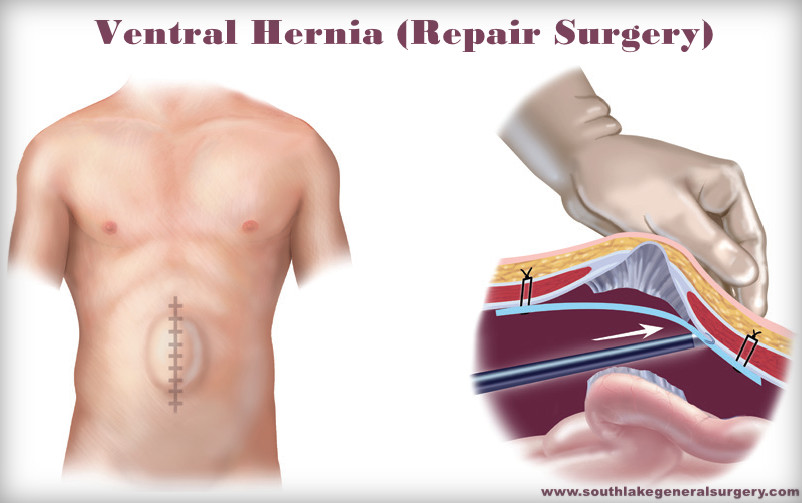A lump of tissue through an opening of a weakened area of abdominal wall muscles is known as a Ventral Hernia. It can develop at any location on the abdominal wall. Many are known as incisional hernias since they structure at the existing healed surgical site.
This abdominal site has become weak or thin, causing abdominal cavity substance to push through. If intestinal tissues get firmly captured inside an opening in the abdominal wall is called a strangulated ventral hernia. This tissue can’t be pushed back into the abdominal cavity and it cuts the blood supply. This condition of ventral hernia requires immediate medical assistance or surgery.
Hernia can happen at any part of the body and is named after the area where they form – for instance, a femoral hernia happens in the upper thigh.
Risk factors of a ventral hernia
Many individuals are born with a certain deformity — one existing from birth — that makes their abdominal wall strangely thin. They are at more severe risk for causing a ventral hernia. There are risk factors for a ventral hernia which may include:
- overweight
- pregnancy
- family history of hernias
- history of past hernias
- injuries to the bowel area
- history of abdominal surgeries
- often lifting or pushing heavy objects
Causes of a Ventral Hernia
According to Dr. Valeria Simone MD, Southlake General Surgery, Texas, individuals with abdominal surgery recently or in past may increase the chances of incisional hernias by 30 percent. Many incisional hernias develop at a surgical site scar. The scar tissue weakens or gets thin can allow a lump to form in the abdomen. This lump is tissue or organs pushing against your abdominal wall.
How do you identify the symptoms of a ventral hernia?
Ventral hernias can deliver a variety of symptoms. These symptoms may take weeks or months to show up. You might not be able to notice any symptoms. Perhaps, you could experience discomfort or severe pain in the affected area, which may deteriorate when you attempt to stand or lift heavy items. A lump or a swelling in the affected can be experienced that feels tender to touch.
If any of the following are experienced, immediately consult a doctor:
- vomiting
- nausea
- pain in abdomen
- mild distress in the abdominal area
- outward swelling or lump of skin or tissues in your abdominal area
How to diagnose a ventral hernia?
Your doctor will ask for some information about your symptoms and do a physical examination for a complete diagnosis. Your doctor may also suggest for imaging test to see inside your body for indication of a ventral hernia. It may include:
- ultrasound
- CT scan
- MRI scan
Treatment for a Ventral Hernia
Hernia surgery may require fixing a ventral hernia. If it is ignored, it keeps on growing until they cause serious complications.
Untreated hernias can become expanded ventral hernias that become dynamically more complex to fix. Swelling in the affected area can lead to trapping of hernia substance, a cycle called incarceration. Strangulation is the medical term for when this condition restricts the flow of blood to the affected tissues.
- Mesh positioning surgery: A surgeon pushes tissue once again into the right spot and afterward places it in a mesh, which fills in as a strengthening patch and holds the place. This is viewed as safe and reliable, and mesh position appears to decrease the risk of hernia recurrence.
- Laparoscopic repair surgery: A surgeon makes multiple small incisions and repairs your hernia using a laparoscope and a mesh may or may not be used.
- Open surgery (non-laparoscopic procedure): A surgeon makes a large incision adjacent to a hernia, pushes the tissues again into the right spot, and stitches the incision. A hernia mesh might be an option in this situation.
Laparoscopic hernia repair offers the following advantages:
- Small multiple incisions, reduce the possibility of infection
- Less pain after surgery
- No or minimal hospital stay — generally you can leave the same day or day after the procedure
- no large scar
- faster overall recovery time
These are a few cons about open surgery:
- the longer hospital stay after surgery
- a greater amount of pain
- medium to a large scar
What are the complications?
Huge ventral hernias are those that have a length or width of in any event 15 centimeters (cm) or a general zone of 150 cm2. They represent a serious surgical risk. The goliath hernia fills the abdominal cavity, making it hard to isolate from encompassing organs. As the hernia increases in size, the danger of a re-occurrence likewise gets higher.
There are different complications of untreated hernias which may include:
- Incarceration: It’s impossible to push the intestines back into the abdominal cavity when they’re stuck in a weakened abdominal wall. This may create a blockage to the intestines or restrict its blood supply.
- Strangulation: Deficiency of blood flow to the intestines can cause this condition. Some portions of the intestines may pass on or start to rot. A quick surgical procedure is important to re-establish blood supply and save the intestines.
Appointment
For more information on Hernia and Surgical procedures. Please contact our healthcare expert today at +1 817-748-0200 or can post your inquiries for online consultation and appointment.

